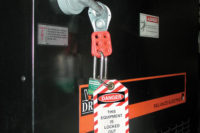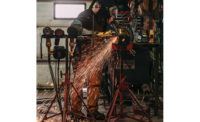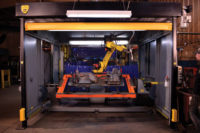Their first and most important consideration is that the hazard be 'engineered out,' that is, be eliminated altogether from the employee work zone. When this approach is not possible, then the second recommended approach must be used. That is, to safeguard the hazard and prevent any part of the employee's body from entering the hazard or point of operation. Most hazards on machinery are controlled by safeguarding.
The most commonly identified methods of safeguarding machinery are: barrier guards, devices (presence sensing/interlocks), safety controls and enclosures.
Once you've thoroughly analyzed the hazard and know the extent of the exposure, you can choose the type of safeguarding you need.
Since OSHA began in 1970, machine safeguarding has been a continual presence among its top 20 citations, and more significantly, high on its list of priorities for the protection of workers.
One of the most frequently asked questions when reviewing machine safeguarding requirements is, "How do I select the most appropriate safeguarding to protect my employees from injury while trying to maintain the highest level of productivity with the machine?"
Several methods are used to determine what level of protection is required for both the point of operation(s) and the danger zone(s) on each machine. The starting point, however, for any evaluation is the standard(s) used to develop and implement machine safeguarding.
First, study the standards There are three primary types of machine safeguarding standards in the U.S. and one main standard in Europe. In the U.S., we have:
- federal and some state regulations, (commonly known as 29 CFR 1910 [OSHA]). However, a number of states have their own 'OSHA-like' standards, i.e. California [CALOSHA] and Tennessee (TENOSHA), etc. These mandatory regulations are the minimum legal requirements established by law that an employer must provide to the employee;
- national consensus standards such as the American National Standards Institute (ANSI), the National Fire Protection Association (NFPA) and others such as SAE, NIOSH, IEC, ISO including other national or international standards as applicable; and
- corporate or company standards that exceed regulatory standards.
A common thread through all of the U.S. regulations and standards, as well as the European Machinery Directive, is that a uniform evaluative process is necessary to appraise each of the hazards on the machine. This process must be used to accurately determine the scope of your program and to develop what level of safeguarding protection is required.
The OSHA/ANSI (OSHA 29 CFR 1910; OSHA 3067; ANSI B11.19)and European Machinery Directive's approach to controlling machine hazards is: eliminate the hazard by design; control the hazard by guarding; post warnings; select personal protective equipment and provide training.
The European Machinery Directive is very similar to U.S. standards, but more process-driven and detailed. It says, determine the limits of the machine; perform risk assessment; check control reliability for safety related functions; identify hazards; eliminate hazard or reduce risk of hazard to an acceptable level; provide warnings; and develop information regarding training, maintenance and technical aspects.
Then, follow all steps
The first step in safeguarding, all three of the national standards agree, is to eliminate the hazard completely or the hazard must be 'engineered out.' To totally eliminate or enclose the exposure on a machine such that the employee has almost zero exposure may not be a practical or cost effective way of doing business. Zero exposure is not usually attainable or practical but you can minimize employee exposure to injury.The second step – determining the necessary level of protection – is often driven by specific regulatory requirements. The OSHA Act of 1970, Section 1, requires all employers "to provide a workplace free of recognized hazards" and, as a general statement, sets forth OSHA's philosophy for safeguarding the workplace. 29 CFR 1910.212(a) defines guarding ". . . one or more methods of machine guarding shall be provided. . ." while 29 CFR 1910.212(a)(3)(ii) " . . . The point of operation . . . shall be guarded" specifically states the actual requirement for guarding. All of these regulations point to the need to reduce the employee's exposure to the identified hazard(s) through the use of physical safeguarding. This approach is where safeguarding may be applied through proven concepts and designs such as distance and time, barriers, interlocked guards, presence sensing devices, enclosures and various other combinations of guarding.
The third step is to begin a risk assessment and evaluation procedure to verify the level of safeguarding needed rather than relying on your 'intuitive' nature when thinking about machine guarding.
Consider all factors
There are only two significant factors to consider: the severity of foreseeable injuries which could occur at these locations and the probability of their occurrence during all phases of the operation. It would also include the exposure to the maintenance staff while they work on the machine up to the point when lockout-tagout is required.When evaluating the probability of an injury, include the following as a minimum, but don't be limited by them:
- machine operation (all phases),
- setup; start-up,
- service adjustments,
- lubrication,
- clearing jams or malfunctions,
- loading and unloading,
- cleaning; shutting down,
- maintenance,
- foreseeable misuse of the machinery and equipment and
- evaluating human response to determine the frequency of exposure to the danger points.
Absence of an injury from a particular exposure or hazard does not mean the injury will never occur or the machine is completely safe. Accidents are unplanned events which occur more or less randomly and usually result in pain and suffering in addition to loss of income for the employee and the company.
The degree of possible injury has a significant influence on determining the level of safeguarding required to provide protection for employees from any given exposure or hazard. The degree of injury can vary from minor lacerations or contusions to the highest risk which would be a fatality. Most injuries are acute and happen immediately. Others are chronic and may not manifest themselves physically for a long period, even years later. So, pay careful attention to each and every exposure on a machine. Take nothing for granted.
When determining the potential degree of injury consider:
- the physical or mechanical hazards involved,
- the injuries that can occur,
- the probability of each type of injury, given the conditions of access to the danger zone or point of operation, and
- the potential loss to the employee and the company that the injury represents.
Review the European Machinery Directive standards prior to starting the risk assessment. Some of the details and specifics given will help you design a more effective machine guarding system.
- EN 292-1 & -2 Safety of Machinery-Basic Concepts, general principles for design
- EN 954-1 Safety related parts of control systems-General principles for design
- EN 1050 Safety of Machinery-Principles of risk assessment.
Another valuable reference is the new Sti (Scientific Technology Inc.) publication, "Guide to Machine & Process Safeguarding" (Sti No. 99276-0010). It provides an overview of the theory and practice of safeguarding and lists protective measures required by the European Machinery Directive.
Assess the risks
It is far too easy to overlook some aspect of exposure control and the extent of an employee's exposure to injury and pain. So all safeguarding should be evaluated through a risk assessment process. This will help you accurately determine if the proposed safeguarding is adequate and appropriate to the situation.One of the most concise but comprehensive approaches to analyzing the potential (risk) of loss is the British Standard 5304:(1988). (ANSI's risk assessment committe – B11.TR3 – is developing a standard. It is expected to be out in a year.) This is the most fundamental and basic approach to risk management required in the European Machinery Directive and the CE process. It is structured yet flexible, and can be modified to fit your individual needs within your own safety management programs.
The technique of risk assessment formalizes the often intuitive process by which designers and safety engineers use their experience to identify hazards, assess risks, and select the appropriate safeguarding. When assessing the risks keep in mind the severity of foreseeable injuries and the probabilities of their occurrence. Accidents are unplanned events and a careful and complete exposure evaluation is important.
An example
For example, the safest way to travel is to fly. Accident statistics clearly show it is the safest way to go from one point to another. Apply the risk assessment approach to this process and see how it might work.Probably the major concern about flying is, "Will I fall out of the sky?" If you apply the evaluation process mentioned above it would go something like this:
1. Probability of injury
What is the probability of an accident and injury?
unlikely – can be assumed the event will not occur possible – under specific conditions probably – likely to occur sometime in the life of the machine certain – likely to occur frequently
2. Severity of injury
What degree of injury may result?
fatality major – normally irreversible serious – normally reversible minor – cuts, bruises, minor abrasions
3. Frequency of exposure
What is the frequency of the exposure?
frequent – several times a day occasional – daily seldom – weekly, monthly or less
Note all of these questions are open-ended and require a significant amount of thought to arrive at an answer. This thought matrix can be customized to suit your safety management process and organization.
Going back to the example of flying, see how you can apply the risk assessment. The probability question could reasonably be answered by either: 1) unlikely or 2) possible under specific conditions. The specific examples could be such conditions as engine failure, severe weather events, fatigue of aircraft structure and similar major events that could lead to a catastrophic failure and the resulting loss of flight. The severity question could be answered from any of the four statements listed depending upon the severity of the event but could also be answered as none. The frequency question may have the same answer and range from none to the highest level of several times per day.
If you try to summarize this example of risk assessment of flying it would probably come out that the likelihood of an accident or injury would be very unlikely or almost none, while the severity of the accident could be catastrophic and include death.
This is gross oversimplification of a risk assessment but the process can and must be applied to every situation where an accident or employee injury may potentially occur. Safety measures should always based on consequence rather than by coincidence in your facility.
Sidebar: OSHA On Machine Guarding
When Congress passed the Occupational Health and Safety Act in 1970 the intent was stated in Section 1, "an act to assure safe and healthful working conditions for men and women." Legislation attached to the public law included the 29 CFR 1910 which covered the details of this generalization for the workplace.In the 1910 standards, Subpart O covers machine safeguarding regulations. Two of OSHA's most important statements point out the need to protect your most valuable asset, your employees. These statements are:
1. 1910.212 (a) Machine Guarding (1) types of guarding "one or more methods of machine safeguarding shall be provided to protect the operator and other employees in the machine area from hazards such as those created by the point of operation, ingoing nip points, rotating parts, flying chips, and sparks.
2. 1910.212(a)(3)(ii) The point of operation of machines whose operation exposes an employee to injury shall be guarded.
These two regulations clearly state that the danger zone and point of operation shall be guarded.
This is the basis for all machine safeguarding. Machine safeguarding is no longer subjective. It is a clear requirement of OSHA.
OSHA's philosophy about machine safeguarding is spelled out in OSHA document 3067, 'Concepts and Techniques of Machine Safeguarding.' Safeguarding is grouped into five general classifications:
- Guards – Fixed, Interlocked, Adjustable, Self-adjusting
- Devices – Presence Sensing, photoelectrical (optical), radio frequency (capacitance), Electromechanical, Pullback, Restraint, Safety Controls, (Safety Trip control Pressure sensitive body bar, Safety tripwire cable, Two-hand control, Two-hand trip) and Gates (Interlocked)
- Location / distance
- Feeding and ejection methods – Automatic feed, Semi-automatic feed, Automatic ejection, Robot
- Miscellaneous aids – awareness barriers, miscellaneous protective shields, hand feeding tools and fixtures.


